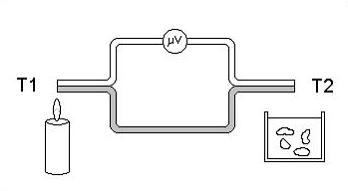Thermocouples
| This article will be released soon. |
Thermocouples ==
The basis of Thermocouples[1] is the effect, that the bond between to different metals causes a current that increases when temperature rises [Nau:2007]Title: Elektrische Temperaturmessung mit Thermoelementen und Widerstandsthermometern
Author: Nau, Matthias . In comparison to the resistance thermometers, they have the clear advantage of a higher upper limit temperature of up to several thousand degrees Celsius. However, their long-term stability is not as good and the measuring accuracy slightly lower (average ±0.75% measuring range).
. In comparison to the resistance thermometers, they have the clear advantage of a higher upper limit temperature of up to several thousand degrees Celsius. However, their long-term stability is not as good and the measuring accuracy slightly lower (average ±0.75% measuring range).
|
The thermocouple is an active sensor, it operates without supplemental energy. It does not measure absolute temperature, but a temperature difference.' |
Basic principle: The lattice electrons are in continuous thermal motion, therefore some are able to leave the surface. In order to counter act the forces of the bond, there must be a work function. This has to be brought on by thermal energy. If different kinds of metals or alloys come into contact, the electrons from the lower work function move to the metal with the higher work function. The first metal is therefore charged positively in contrast to the second metal and a contact current emerges, also known as the Seebeck effect. If the contacts have different temperatures, a current flows that is dependent on the resistance in the circuit and the difference of contact stresses (called thermal voltage). ??????
By combining different metals or alloys, a series of sensors for a very high temperature range are made possible. For thermocouples the IEC standard 584 applies. Most common is type K.
:
| Type | Metal 1 Pluspole | Metal 2 Minuspole | Temp. coeff. average | Application |
| T | Cu | Cu-Ni | 42.8 mV/°C | -200 . . . +600 °C |
| J | Fe | Cu-Ni | 51.7 mV/°C | -200 . . . +900 °C |
| E | Cr-Ni | Cu-Ni | 60.9 mV/°C | -200 . . . +1000 °C |
| K | Cr-Ni | Ni | 40.5 mV/°C | -200 . . . +1300 °C |
| S | Pt | Pt-10%Rh | 6.4 mV/°C | 0 . . . +1500 °C |
| R | Pt | Pt-13%Rh | 6.4 mV/°C | 0 . . . +1600 °C |
| B | Pt-6%Rh | Pt-30%Rh | 0 . . . +1800 °C | |
| G | Tu | Tu-26%Re | 0 . . . +2800 °C | |
| C | Tu-5%Re | Tu-26%Re | 15.0 mV/°C | 0 . . . +2800 °C |
Thermocouple measurement is basically a differential temperature measurement between one measuring point Tm and a reference point Tv. For measuring the absolute temperature of a specific measuring point:
1. The temperature of the reference point is kept constant. A certain voltage has to be subtracted inside electronic evaluation system. The reference point also needs a temperature control.
2. The temperature of the reference point is measured be a second temperature sensor. Then the evaluation electronic has to subtract the appropriate value.
Literature
| [Nau:2007] | Nau, Matthias (2007): Elektrische Temperaturmessung mit Thermoelementen und Widerstandsthermometern, JUMO |  |
- ↑ http://de.wikipedia.org/w/index.php?title=Thermoelement&oldid=75879984 gelesen 28.07.2010
